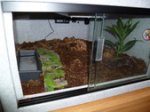The Comish
New member
- Joined
- Aug 9, 2010
- Messages
- 2
- Reaction score
- 0
- Points
- 0
- Country
- United States
I have two small tiger salamanders in the 24" by 24" Vision cage. I have bed-a-beast substrate with moss on top. There is a small water dish so they can get in and out especially with the help of the decorative walkway next to it. I have a fan on top to keep it cool during the day and a fogger set for night time to moisten the soil and moss. This does raise the temp some as the humidity rises. With the heat it has been tought to keep the cage below 70, but checking the soil temps it usually is around 66 degrees. I rarely see one of the salamanders and the other one comes out when he is hungry and eats well. But his skin seems dry and the soil is sticking to him. He does not like being sprayed very much either. Can I do anything better to improve their living conditions? I just don't seem to have a good balance yet and I am concered with not seeing the other salamander, but I can find him if I dig around, but that disrupts everything...any comments are truly appreciate

